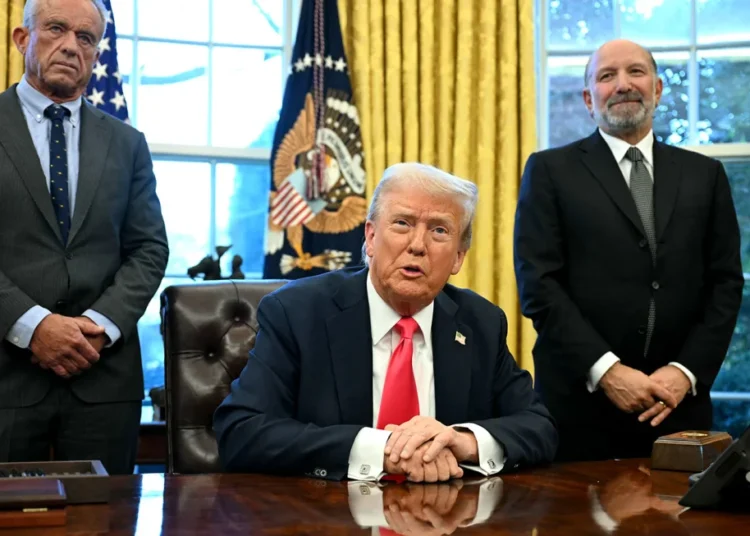Trump’s Gold Card: A Controversial Alternative to the Green Card?
Former U.S. President Donald Trump’s proposal to introduce a “Gold Card” visa as an alternative to the Green Card has sparked widespread debate. The program, which would offer wealthy foreign investors the ability to live, work, and pursue U.S. citizenship in exchange for a $5 million payment, has faced significant backlash from policymakers, immigration experts, and economic analysts.
While Trump claims the program could generate trillions for the U.S. economy, critics argue that it favors the ultra-wealthy, undermines traditional immigration pathways, and raises ethical concerns about a pay-for-citizenship model.
With the 2025 election cycle underway, Trump’s immigration proposals are once again taking center stage. But will the Gold Card visa succeed, or is it destined to fail?
What Is Trump’s Gold Card, and How Does It Work?
The Gold Card is designed as a fast-track residency program for high-net-worth individuals, requiring a $5 million upfront payment to the U.S. government. Unlike the existing EB-5 visa program, which mandates job creation and business investment, the Gold Card would have no economic contribution requirements beyond the one-time payment.
The key promises of the Gold Card program include:
•Permanent U.S. residency with no work restrictions.
• A path to U.S. citizenship, similar to the Green Card process.
• No need to create jobs or make business investments—just a simple financial transaction.
Supporters of the plan argue that this would bring immediate revenue to the U.S., attracting the wealthiest investors worldwide while streamlining the often-complicated immigration process. However, critics see the Gold Card as an elitist approach to residency, making U.S. immigration policy more about money than merit.
Criticism: A Visa Only for the Wealthy?
The biggest controversy surrounding the Gold Card is its exclusivity to the ultra-rich. Traditional immigration pathways, such as the EB-5 investor visa, require not just financial investment but also job creation and economic contribution. The H-1B visa, another major immigration route, prioritizes high-skilled professionals in industries like tech, healthcare, and engineering.
Critics argue that:
•The Gold Card eliminates merit-based immigration, prioritizing wealth over skills, entrepreneurship, or employment needs.
•It sends the wrong message, suggesting that U.S. residency can be bought, rather than earned through work, investment, or family sponsorship.
•There are ethical concerns about allowing only the world’s richest individuals to bypass standard immigration requirements.
While Trump has positioned the Gold Card as a revenue-generating opportunity, opponents believe it could further widen inequality in the U.S. immigration system.
Will the Gold Card Actually Boost the U.S. Economy?
Trump has claimed that if one million applicants purchase the Gold Card, the U.S. could raise $5 trillion in revenue—a staggering figure that could theoretically eliminate national debt and boost federal budgets. However, economic analysts are skeptical about whether this would translate into actual benefits.
Potential economic concerns include:
•Limited Demand: A $5 million price tag makes this visa accessible to only a tiny fraction of the world’s wealthy elite.
•Capital Outflow Risks: Many high-net-worth individuals use tax havens to protect their assets, meaning the U.S. might not capture as much financial benefit as expected.
•No Job Creation: Unlike the EB-5 program, which requires investors to generate at least 10 jobs, the Gold Card has no economic engagement requirements, reducing its long-term impact.
Without business or job creation incentives, the Gold Card risks becoming merely a luxury residency permit rather than a program that actively contributes to U.S. economic growth.
The Political Implications: Will It Even Pass?
Even if Trump wins a second term, passing the Gold Card proposal through Congress remains a major challenge. Immigration remains one of the most polarizing issues in U.S. politics, and many lawmakers—including some within Trump’s own party—may reject a policy that prioritizes wealth over skills or employment needs.
Key political challenges include:
• Democratic opposition: Democrats have long pushed for immigration reform based on skills, family reunification, and economic contribution—not wealth alone.
• Republican division: Some conservatives may oppose the idea of selling U.S. residency outright, seeing it as a departure from traditional immigration values.
•Legal barriers: Creating an entirely new visa category would require major legislative changes, which could face legal and constitutional challenges.
The 2025 elections will play a crucial role in determining whether the Gold Card even remains part of Trump’s policy platform. If he secures the presidency, immigration policy changes are inevitable—but whether the Gold Card makes it into law is another question entirely.
Conclusion: A Golden Opportunity or a Failed Proposal?
Trump’s Gold Card visa proposal is shaping up to be one of the most controversial immigration policies in recent U.S. history. While it promises a massive financial boost to the U.S. economy, it also raises ethical concerns about wealth-based residency and departs from traditional job and investment-driven immigration programs.
With significant economic doubts, political opposition, and legal hurdles, the Gold Card may never become a reality. However, as Trump continues to promote the idea as part of his 2025 campaign, it remains a hot topic in U.S. immigration debates.














